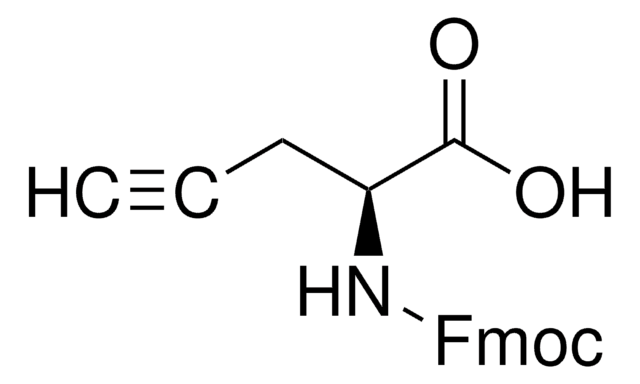Alle Fotos(2)
Wichtige Dokumente
900893
L-Homopropargylglycine hydrochloride
Synonym(e):
HPG
Anmeldenzur Ansicht organisationsspezifischer und vertraglich vereinbarter Preise
Alle Fotos(2)
About This Item
Empirische Formel (Hill-System):
C6H9NO2 · HCl
CAS-Nummer:
Molekulargewicht:
163.60
UNSPSC-Code:
12352209
NACRES:
NA.22
Empfohlene Produkte
Form
powder or crystals
Verfügbarkeit
available only in USA
mp (Schmelzpunkt)
162 °C
Lagertemp.
−20°C
SMILES String
O=C(O[H])[C@@](C([H])([H])C([H])([H])C#C[H])([H])N([H])[H].Cl[H]
InChI
1S/C6H9NO2/c1-2-3-4-5(7)6(8)9/h1,5H,3-4,7H2,(H,8,9)
InChIKey
SCGJGNWMYSYORS-UHFFFAOYSA-N
Anwendung
L-Homopropargylglycine (HPG) is an amino acid analog of methionine that contains a very small modification, specifically an alkyne moiety. This compound can be fed to cultured cells and incorporated into proteins during active protein synthesis. Detection utilizes the chemoselective ligation or “click” reaction between an azide and an alkyne or cyclooctyne. For example the alkyne-modified protein can be detected with either fluorescent azide or biotin azide. Detection sensitivity with these reagents in 1-D gels and Western blots is in the low femtomole range and compatible with downstream LC-MS/MS and MALDI-MS analysis.
Signalwort
Danger
H-Sätze
Gefahreneinstufungen
Self-react. C
Lagerklassenschlüssel
5.2 - Organic peroxides and self-reacting hazardous materials
WGK
WGK 3
Flammpunkt (°F)
Not applicable
Flammpunkt (°C)
Not applicable
Hier finden Sie alle aktuellen Versionen:
Besitzen Sie dieses Produkt bereits?
In der Dokumentenbibliothek finden Sie die Dokumentation zu den Produkten, die Sie kürzlich erworben haben.
Kunden haben sich ebenfalls angesehen
Cleavable biotin probes for labeling of biomolecules via azide? alkyne cycloaddition.
Szychowski J, et al.
Journal of the American Chemical Society, 132(51), 18351-18360 (2010)
Using Click-Chemistry for Visualizing in Situ Changes of Translational Activity in Planktonic Marine Bacteria.
Leizeaga A, et al.
Frontiers in Microbiology, 8 (2017)
Cell-free production of Gaussia princeps luciferase?antibody fragment bioconjugates for ex vivo detection of tumor cells.
Patel K G, et al.
Biochemical and Biophysical Research Communications, 390(3), 971-976 (2009)
The dynamic shuttling of SIRT1 between cytoplasm and nuclei in bronchial epithelial cells by single and repeated cigarette smoke exposure.
Yanagisawa S, et al.
PLoS ONE, 13(3), e0193921-e0193921 (2018)
Live-cell imaging of alkyne-tagged small biomolecules by stimulated Raman scattering.
Wei L, et al.
Nature Methods, 11(4), 410-410 (2014)
Unser Team von Wissenschaftlern verfügt über Erfahrung in allen Forschungsbereichen einschließlich Life Science, Materialwissenschaften, chemischer Synthese, Chromatographie, Analytik und vielen mehr..
Setzen Sie sich mit dem technischen Dienst in Verbindung.

